Related Research Articles

Patañjali, also called Gonardiya, or Gonikaputra, was a sage in Ancient India. Very little is known about him, and no one knows exactly when he lived. It is estimated from analysis of his works that it was between the 4th and 5th centuries CE.

A shoe is an item of footwear intended to protect and comfort the human foot. Shoes are also used as an item of decoration and fashion. The design of shoes has varied enormously through time and from culture to culture, with form originally being tied to function. Though the human foot can adapt to varied terrains and climate conditions, it is still vulnerable to environmental hazards such as sharp rocks and temperature extremes, which shoes protect against. Some shoes are worn as safety equipment, such as steel-toe boots which are required footwear at industrial worksites.

Footwear refers to garments worn on the feet, which typically serves the purpose of protection against adversities of the environment such as wear from ground textures and temperature. Footwear in the manner of shoes therefore primarily serves the purpose to ease locomotion and prevent injuries. Footwear can also be used for fashion and adornment as well as to indicate the status or rank of the person within a social structure. Socks and other hosiery are typically worn additionally between the feet and other footwear for further comfort and relief. Cultures have different customs regarding footwear. These include not using any in some situations, usually bearing a symbolic meaning. This can however also be imposed on specific individuals to place them at a practical disadvantage against shod people, if they are excluded from having footwear available or are prohibited from using any. This usually takes place in situations of captivity, such as imprisonment or slavery, where the groups are among other things distinctly divided by whether or whether not footwear is being worn.

Clogs are a type of footwear made in part or completely from wood. Used worldwide, their forms can vary by culture, but often remained unchanged for centuries within a culture.

Slippers are light footwear that are easy to put on and off and are intended to be worn indoors, particularly at home. They provide comfort and protection for the feet when walking indoors.

Flip-flops are a type of light sandal, typically worn as a form of casual footwear. They consist of a flat sole held loosely on the foot by a Y-shaped strap known as a toe thong that passes between the first and second toes and around both sides of the foot or can be a rigid base with a strap across all the toes.

Zori, also rendered as zōri, are thonged Japanese sandals made of rice straw, cloth, lacquered wood, leather, rubber, or—most commonly and informally—synthetic materials. They are a slip-on descendant of the tied-on waraji sandal.

Geta (下駄) are traditional Japanese footwear resembling flip-flops. A kind of sandal, geta have a flat wooden base elevated with up to three "teeth", held on the foot with a fabric thong, which keeps the foot raised above the ground.

Waraji are light tie-on sandals, made from ropemaking fibers, that were the standard footwear of the common people in Japan.
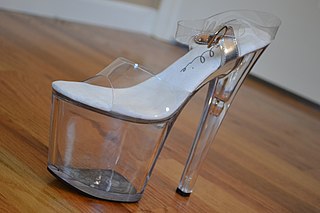
Platform shoes are shoes, boots, or sandals with an obvious thick sole, usually in the range of 3–10 cm (1–4 in). Platform shoes may also be high heels, in which case the heel is raised significantly higher than the ball of the foot. Extreme heights, of both the sole and heel, can be found in fetish footwear such as ballet boots, where the sole may be up to 20 cm (8 in) high and the heels up to 40 cm (16 in) or more. The sole of a platform shoe can have a continuous uniform thickness, have a wedge, a separate block or a stiletto heel. Raising the ankle increases the risk of a sprained ankle.

Sandals are an open type of footwear, consisting of a sole held to the wearer's foot by straps going over the instep and around the ankle. Sandals can also have a heel. While the distinction between sandals and other types of footwear can sometimes be blurry, the common understanding is that a sandal leaves all or most of the foot exposed. People may choose to wear sandals for several reasons, among them comfort in warm weather, economy, and as a fashion choice.

Shoemaking is the process of making footwear.

Opanci are traditional peasant shoes worn in Southeastern Europe. The attributes of the opanci are a construction of leather, lack of laces, durable, and various endings on toes. In Serbia, the design of the horn-like ending on toes indicates the region of origin, though this specific design is not exclusive to Serbia. The opanci are also considered as the traditional peasant footwear for people in the Balkan region. In Bulgaria they are referred to as "tsarvuli".
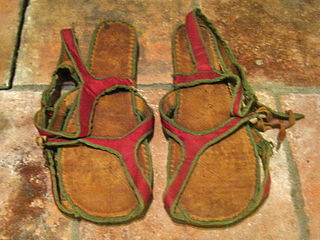
Episcopal sandals, also known as the pontifical sandals, are a Roman Catholic pontifical vestment worn by bishops when celebrating liturgical functions according to the pre–Vatican II rubrics, for example a Tridentine Solemn Pontifical Mass.

The jutti or Punjabi Jutti is a type of footwear common in North India and neighboring regions. They are traditionally made up of leather and with extensive embroidery, in real gold and silver thread as inspired by Indian royalty over 400 years ago. Prior to that, Rajputs of the northwest used to wear leather juttis, also called ethnic shoes. Now with changing times, different juttis with rubber soles are made available. Besides the Punjabi jutti, there are various local styles as well. Today Amritsar and Patiala are important trade centers for handcrafted juttis, from where they are exported all over the world to Punjabi diaspora. Closely related to mojaris. Juttis have evolved into several localized design variations, even depending upon the shoemaker. However by large, they have no left or right distinction, and over time take the shape of the foot. They usually have flat sole, and are similar in design for both women and men, except for men they have a sharp extended tip, nokh curved upwards like traditional moustaches, and are also called khussa, and some women’s juttis are backless. Even with changing times juttis have remained part of ceremonial attire, especially at weddings, the unembellished juttis are used for everyday use for both men and women in most of Punjab, mostly called Jalsa Jutti which is blackish in color.

A dress shoe is a shoe to be worn at smart casual or more formal events. A dress shoe is typically contrasted to an athletic shoe.
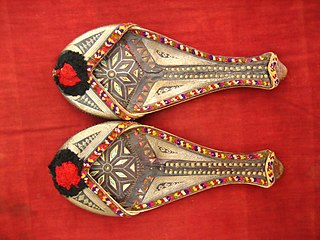
Sindhi Mojari is a type of handcrafted footwear produced in Pakistan. They are traditionally made by artisans mostly using tanned leather. The uppers are made of one piece of leather or textile embroidered and embellished with brass nails, cowry shells, mirrors, bells and ceramic beads. Even the bonding from the upper to the sole is done by cotton thread that is not only eco-friendly but also enmeshes the leather fibers with great strength. Some product range also uses bright and ornate threads.

Paduka is an ancient form of footwear in India, consisting of little more than a sole with a post and knob which is engaged between the big and second toe. It has been historically worn in South Asia and Southeast Asia. Paduka exist in a variety of forms and materials. They might be made in the shape of actual feet, or of fish, for example, and have been made of wood, ivory and silver. They may be elaborately decorated, such as when used as part of a bride's trousseau, but could also be given as religious offerings or themselves be the object of veneration.
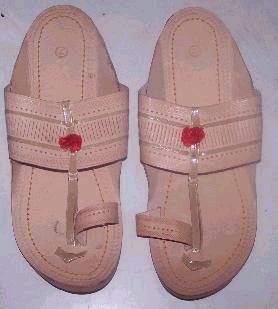
Kolhapuri chappals are Indian decorative hand-crafted and braided leather slippers that are locally tanned using vegetable dyes. Kolhapuri Chappals or Kolhapuris as they are commonly referred to are a style of open-toed, T-strap sandal, but also braided leather Mules or braided leather shoe type designs are also common.
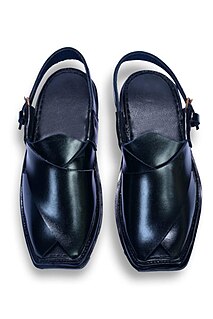
The Peshawari chappal is a traditional type of footwear of Pashtuns, worn especially by Pashtuns in the Khyber Pakhtunkhwa region. The shoe takes its name from the city of Peshawar, where it originates. While chappal is the word for flip-flops or sandals in Urdu, locals in Peshawar call the Peshawari Tsaplay. The shoes are worn by men casually or formally, usually with the shalwar kameez. Because of their comfort, they are worn in place of sandals or slippers in Pakistan.
References
- 1 2 What is the history of Indian footwear like Paduka, Juti?
- 1 2 3 4 Jutta Jain-Neubauer (2000). Feet & Footwear in Indian Culture. Bata Shoe Museum. ISBN 978-81-858226-9-3.
- 1 2 Rukmini Bhaya Nair; Peter Ronald deSouza (1968). Keywords for India: A Conceptual Lexicon for the 21st Century. Bloomsbury Publishing.
- 1 2 3 4 5 Raj Kumar (2008). Encyclopaedia of Untouchables Ancient, Medieval and Modern. Gyan Publishing House. ISBN 978-81-783566-4-8.
- ↑ Baij Nath Puri (1968). India in the Time of Patañjali. Bharatiya Vidya Bhavan.